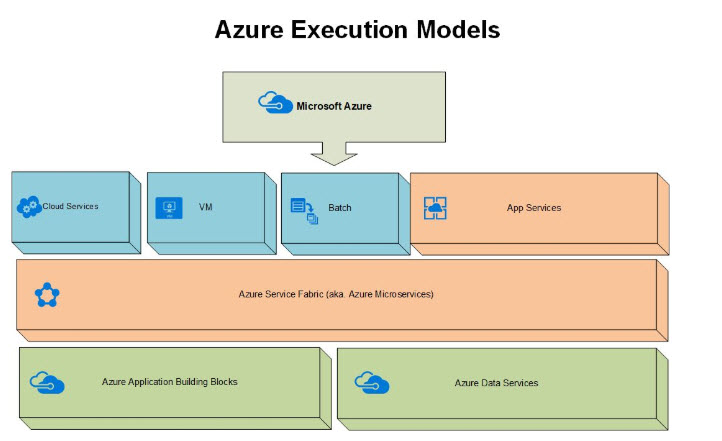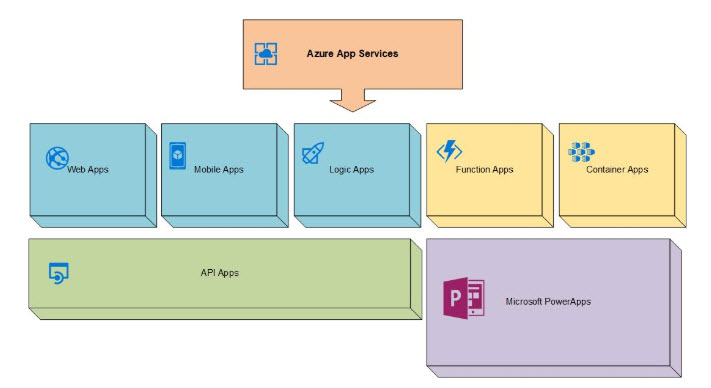Now that we have acquired the basic knowledge about cloud computing as per my previous blog. Link is given below. Before reading this blog please go check the previous article to get to know the basics .
Cloud Service Models and differences between them
I think that when we start talking about the Microsoft Azure Platform, we should first talk about running applications in the cloud .The executions models in Azure are outlined in the following diagram.

Cloud Services: Cloud Services are the oldest part of Azure platform . Its offered as a PaaS service from Azure and its the leading solution .Cloud Services are highly available , scalable, and multi-layered web apps hosted on a Windows Virtual machine with an installed IIS.
Virtual Machines (VM) : This model is the IaaS offering from Azure. With VMs(whether Windows or Linux OS) you have the flexibility to realize your own workloads .There are over 3000 prefabricated images available in Azure Market place.
Batch : Azure Batch is a platform service for running large-scale parallel and high performance computing (HPC) applications efficiently in the cloud.
Websites : This model is now part of Azure App services but this model is used to create and deploy websites.
Mobile Services: This model is also now part of Azure app services and with this model you can quickly create and host a backend for any mobile device.
And each of these models can be used independently or in combination .
Azure App services
As per the diagram that you see above website and mobile services are part of Azure App services but Azure App Services has so much more to offer as shown in the diagram below:

Lets explore Azure App services :
Web Apps : Web apps is the new name for the Azure websites’ execution model and does not differ much in its functionality from the previous component but there are some extended features.
Mobile Apps: And as the name sounds mobile services is the new name for the Azure mobile services execution model and does not differ much in its functionality from the previous component .
Logic Apps: With Logic apps , you can easily build and deploy powerful integration solutions by automating business processes or or integrating your SaaS and enterprise applications. So you get a visual designer for creating the necessary workflows. And Logic apps are the next evolutionary step in the integration services and the Biz talk services, and starting from 2018 are the only offer in this area.
API Apps : Its a new component and API apps allows you to discover, host, manage, and market APIs and SaaS connectors in a modern, feature-rich , scalable and globally available platform.It is also a complete solution for the enterprise developers and system integrators , which extends the development of Web Apps (mobile applications) with numerous useful features.
Function Apps : This is not really a component of the Azure App Services. The functionality is handled by Azure functions using the Azure App services environment.Easily build the apps you need using simple, server less functions that scale to meet demand. Use the programming language of your choice, and don’t worry about servers or infrastructure.
Container Apps: This is not really a component of the Azure App services. Azure Container Services uses the Azure App Services environment only to handle the functionality.
Microsoft Power Apps : Microsoft Power Apps is also not part of the Azure App Services. Its a SaaS variant of the Azure App Services and uses the Azure App Services and the Azure App Services environment only to handle the functionality .
Azure Service Fabric
We have one more model added which is Azure Service Fabric also known as Azure Micro service Architecture : With Azure Service Fabric , you can focus on building applications and business logic, and let the Azure platform solve all other problems by analyzing reliability, scalability, management, and latency.
Azure application building blocks
There are two other components Azure Application building blocks and Azure Data services:
Media: Azure Media Services provide an extensive portfolio for on-demand and live video processing ,video and audio encoding and many more services.
Cache: The use of a cache allows you high throughput and consistent data access with low latency for fast and scalable Azure applications.The solution for the Azure platform is known as Azure Redis Cache is based on the popular open source Redis cache and has been realized as a fully managed service.
CDN: CDN also known as Content delivery Network offers a global solution for delivering high bandwidth content which is hosted on Azure or any other location(can be an Http/Https location)
Identity : This offers identity services, such as Azure Active Directory(AD), Azure AD B2C, Multi-Factor Authentication, and Azure Key Vault which is basically a safe place for your certificates.
Networking: This category contains the basic Networking services like Azure Express route, Vnet Peering and VPN gateways.
Integration: The integration services include interfaces for hybrid connections, Enterprise Application Integration (EAI) and Electronic Data Interchange (EDI) message processing , an easy to use admin portal for trading partners as well as support for common EDI schemas and comprehensive EDI processing via X12 and AS2.
Messaging : The messaging services include all interfaces from the Azure service Bus not included in the integration category, example Azure Service Bus topics Azure Service Bus Notification Hubs.
Dev Services: These are basically cloud based development tools for version control, collaboration, and other development related tasks, for example Visual Studio Team Services(VSTS) and the Azure DevTest Labs.
IoT: IoT services include the fundamental tools needed to work with devices used for IoT, example IoT hub , IoT edge, and Azure Event Hubs.
Blockchain : Blockchain is a way for business, industries , and organisations to make and verify transactions-streamlining business processes, and reducing the potential for fraud.
For Azure Data Services i will write a separate blog. Please be on the lookout for that topic.


Leave a comment